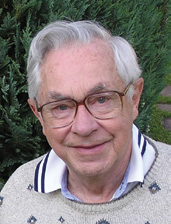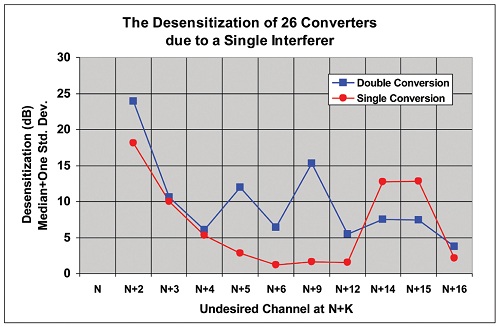Testing Interference on UHF Taboo Channels

Charles W. Rhodes
This time each year I usually present a technical paper dealing with some aspect of DTV reception at the IEEE International Conference on Consumer Electronics and this year is no exception. Very few broadcasters attend this conference. The attendees are the engineers who design consumer electronics products. This conference is where east meets west, so I can connect directly with the engineers who will design most of the DTV receivers for the North American market.
My paper addresses the study that colleagues Linley Gumm and Stanley Knight and I have worked on in 2012. We tested 26 NTIAapproved converter boxes vintage 2008 for their rejection of interference. We assume that they represent, more or less, the population of some 30 million ATSC converter boxes in use in American homes today. With, say, 120 million ATSC receiving devices in the United States, these are a significant part of the population.
The analog front-end of converter boxes and those of DTV receivers are similar, if not identical. Finding out how well these behave in an interference-limited environment, such as we expect after the FCC carries out it announced plan to re-pack the UHF TV spectrum, is a timely idea.
TABOO CHANNEL INTERFERENCE
The FCC regulates co-channel and adjacent channel interference by its channel allotment plan. It does not regulate what I call “taboo channel interference,” a term left over from analog television, meaning one undesired signal two to eight channels above or below the desired signal, or 14 to 15 channels above the desired signals. Taboo channel interference exists because of receiver performance limitations, such as RF selectivity and the effects of nonlinearity, especially of the mixer. So we tested the UHF taboos.
The metric the FCC uses is called the “Desired/Undesired” (D/U) signal power ratio. In analog systems, the D/U of a given receiver for a specified offset between desired and undesired channels is a constant; it does not change with the power of the undesired signal. It is also called the “protection ratio.” If a receiver is nonlinear (mixer overload), the D/U changes with undesired power.

Fig. 1: Double-conversion tuners outperform single-conversion tuners in rejecting interference on N+14 and N+15, but SCTs outperform in rejecting other interference. Our first finding was that, with these 26 ATSC converter boxes, one undesired signal did not drive the mixer into overload as the D/U ratio we measured was constant for a undesired power of from –11 dBm to –41 dBm. This was great news.But, we noted there were two groups of data. We determined that four of these ATSC converters have a double-conversion tuner (DCT) and 22 have a single-conversion tuner (SCT). They behave differently to undesired signals. An SCT has one mixer to convert the desired signal to the intermediate frequency, 44 MHz. The local oscillator frequency is set to be 44 MHz above the desired channel.
The professional video industry's #1 source for news, trends and product and tech information. Sign up below.
A second signal 44 MHz above the local oscillator frequency will also be converted to the intermediate frequency of 44 MHz. This is called the “image response.” The image frequency is 88 MHz above the desired channel. Removing the undesired signal 88 MHz above the desired signal must be done by a filter before the mixer. That means the filter must track the desired frequency. This is called a “tracking filter.” These are expensive to manufacture, so an alternative to a tracking filter was invented. It is the doubleconversion tuner. It does not need a tracking filter. The desired signal is up-converted to a first intermediate frequency, which is above the highest frequency to be received.
Whether the viewer wants to watch Ch. 2 or 51, that signal is up-converted to 1222 MHz in the four units under test with a DCT. Every desired signal frequency is now 1222 MHz. A bandpass filter, which passes all frequencies from 1212 MHz to 1232 MHz, and which attenuates all frequencies below 1200 MHz and above 1240 MHz, rejects nearly all undesired signals, especially the image frequencies. A second mixer converts the desired signal of 1222 MHz down to 44 MHz, the second intermediate frequency.
We found that the median value of the undesired signal power for SCTs was quite different from that of the units with DCTs. If we had published the median for all 26 units, the report would not reflect the performance limitations of the four DCT tuners because that would be masked by the dominant 22 units with an SCT.
MISLEADING DATA
Anyone planning the repacking of the TV spectrum by using this single median would be misled by such data. Remember that, at the median desired power, or median D/U power 50 percent of receivers fail. That didn’t seem to be reasonable criteria for repacking.
So we used a trick every statistician knows; we also calculated the variance of standard deviation. I picked a variance of 1.0 at which 84 percent of receivers have not failed. If the median was –36 dBm, and the variance is 5 db, then if the desired power is increased from –36 dBm to –31 dBm, 84 percent of these units would be working.
While the DCT tuners did better at rejecting image frequency interference, they did worse than the SCT for the other interference tests. This is shown in Fig. 1.
A single, strong undesired signal desensitizes the receiving device because it has a wideband RF AGC system. This controls the gain of the RF amplifier, by sensing the total signal power at the RF input to the mixer. (Remember, it is the mixer that gets overloaded.)
When the RF amplifier gain goes down, the IF amplifier gain goes up and the noise power generated by the mixer goes up too, thus the SNR drops. At an SNR of 15.2 dB, the ATSC signal cannot be decoded, hence reception fails. For example, if a given unit has a noise-limited threshold of –84 dBm, an undesired signal at, say, –23 dBm causes Dmin to increase from –84 dBm to –65 dBm; the loss on sensitivity is 21 dB. This is the desensitization for that unit at that undesired power.
Wideband RF AGC is widely, if not universally, used in DTV tuners to allow them to receive the desired signal when there is a strong undesired signal on an adjacent channel. Our tests show how effective this technique is.
Manufacturers of consumer electronics do not reveal what is inside the product. We determined which units have a DCT by measuring the frequency of the very small local oscillator signal power present at the “F” connector. Spectrum analyzers require a low-noise preamplifier ahead of the analyzer to detect such small signals.
We discovered an easier method. Double conversion tuners in DTV receivers probably have a first intermediate frequency of 1222 MHz. This is the second harmonic of Channel 37 (611 MHz). Units with a first intermediate frequency of 1222 MHz are sensitive to an undesired signal on Channel 37. A signal generator with output at 611 MHz will quickly separate DCT and SCT units.
Charles Rhodes is a consultant in the field of television broadcast technologies and planning. He can be reached via email atcwr@bootit.com.
